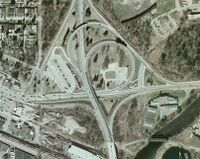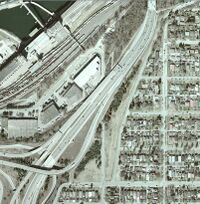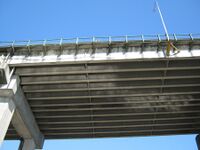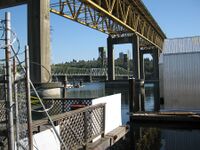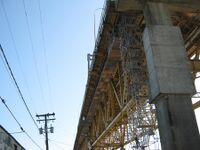Difference between revisions of "Iron Workers Memorial (Second Narrows) Bridge"
imported>Jay MacDonald |
imported>John Dove (some edits to add more clarity and remove the comment about focus which is not relevant to this page) |
||
| Line 19: | Line 19: | ||
** Reduces need to slow down or stop to let opposing cyclists pass |
** Reduces need to slow down or stop to let opposing cyclists pass |
||
** Allows an increasing number of cyclists to use the bridge efficiently |
** Allows an increasing number of cyclists to use the bridge efficiently |
||
| − | * Improved safety at Dollarton off ramp and Main Street on ramp where there is no barrier between the sidewalk and the |
+ | * Improved safety at Dollarton off ramp and Main Street on ramp due to reduced risk from bike collisions where there is no barrier between the sidewalk and the TCH |
* Improved accessibility for and passing of wider-than-normal bikes (bikes with trailers, electric bike scooters, tricycles, etc.) |
* Improved accessibility for and passing of wider-than-normal bikes (bikes with trailers, electric bike scooters, tricycles, etc.) |
||
| Line 26: | Line 26: | ||
** Additional distance for cyclists going from North Vancouver to Burnaby/Vancouver Adanac, from Vancouver Portside to North Vancouver |
** Additional distance for cyclists going from North Vancouver to Burnaby/Vancouver Adanac, from Vancouver Portside to North Vancouver |
||
** Additional elevation gain for cyclists going from North Vancouver to Burnaby/Vancouver Adanac, from Vancouver Portside to North Vancouver because sidewalk along the McGill on ramp goes uphill before dropping down to the bridge head, adding unnecessary elevation gain |
** Additional elevation gain for cyclists going from North Vancouver to Burnaby/Vancouver Adanac, from Vancouver Portside to North Vancouver because sidewalk along the McGill on ramp goes uphill before dropping down to the bridge head, adding unnecessary elevation gain |
||
| − | ** Most cars don’t stop at crosswalk on Skeena St |
+ | ** Most cars don’t stop at crosswalk on Skeena St where access to shared bike path starts |
* Minor (if any) improvement to traffic flow |
* Minor (if any) improvement to traffic flow |
||
** The problem remains that the sidewalks are too narrow for cyclists to pass when going the same direction. If the number of cyclists on the bridge keeps increasing, this may be a more significant bottleneck than slowing down for cyclists going the other way. |
** The problem remains that the sidewalks are too narrow for cyclists to pass when going the same direction. If the number of cyclists on the bridge keeps increasing, this may be a more significant bottleneck than slowing down for cyclists going the other way. |
||
| − | * Focus energy on lobbying for wider sidewalks and better east-west connection at the south end of the bridge |
||
=== Other issues === |
=== Other issues === |
||
| Line 38: | Line 37: | ||
* Approaches and exits are dangerous and difficult. |
* Approaches and exits are dangerous and difficult. |
||
* Way-finding signage to and from bridge is insufficient. |
* Way-finding signage to and from bridge is insufficient. |
||
| − | * Chain link fence between the sidewalk and the on-ramp from McGill |
+ | * Chain link fence between the sidewalk and the TCH on-ramp north bound from McGill |
** Feeling of being locked in between the steep bank and the fence |
** Feeling of being locked in between the steep bank and the fence |
||
** If anything happens there is no easy way to get help or attention (safety concern) |
** If anything happens there is no easy way to get help or attention (safety concern) |
||
| Line 50: | Line 49: | ||
=== Action === |
=== Action === |
||
| − | On October 25th a joint committee was formed between the North Shore, Vancouver and Burnaby committees to formulate a plan for moving forward. |
+ | On October 25th 2010 a joint committee was formed between the North Shore, Vancouver and Burnaby committees to formulate a plan for moving forward. |
Revision as of 16:38, 14 January 2011
Background
In 1992, the Cassiar Connector was constructed and the Ironworkers Memorial Bridge was modestly refurbished (lighting changed, median installed and barriers/railings installed between the traffic and the sidewalks, narrowing the sidewalks but making it less heart-stoppingly perilous to ride in a stiff crosswind). At the time, cycling advocates asked for wider sidewalks and better access to the bridge. The result was somewhat better access on the north side of the bridge and the situation we have now on the south side.
About 8 or 10 years ago cycling advocates, municipal staff and provincial staff got together to determine the best way to regulate the bridge sidewalks. The consensus result was the arrangement now in place – cyclists can use either side but “wrong-way” cyclists must yield.
As part of the Gateway Project consultation, advocates asked the province to upgrade cycling and pedestrian access on the south side by, among other things, providing a connection between the east and west sidewalks. This could be either under the bridge (as at the south end of Lion’s Gate) or over the highway, connecting to the elevated sidewalk/bike path on the east side and therefore needing a ramp structure only on the west side. This request was deemed “beyond the scope of the project”, which apparently ends just short of the bridge head.
Potential one-way rule for cyclists
Pros:
- Better traffic flow
- Reduces need to slow down or stop to let opposing cyclists pass
- Allows an increasing number of cyclists to use the bridge efficiently
- Improved safety at Dollarton off ramp and Main Street on ramp due to reduced risk from bike collisions where there is no barrier between the sidewalk and the TCH
- Improved accessibility for and passing of wider-than-normal bikes (bikes with trailers, electric bike scooters, tricycles, etc.)
Cons:
- Need to use Skeena Tunnel connection as the primary link between east and west bridge sidewalks at the south end of the bridge
- Additional distance for cyclists going from North Vancouver to Burnaby/Vancouver Adanac, from Vancouver Portside to North Vancouver
- Additional elevation gain for cyclists going from North Vancouver to Burnaby/Vancouver Adanac, from Vancouver Portside to North Vancouver because sidewalk along the McGill on ramp goes uphill before dropping down to the bridge head, adding unnecessary elevation gain
- Most cars don’t stop at crosswalk on Skeena St where access to shared bike path starts
- Minor (if any) improvement to traffic flow
- The problem remains that the sidewalks are too narrow for cyclists to pass when going the same direction. If the number of cyclists on the bridge keeps increasing, this may be a more significant bottleneck than slowing down for cyclists going the other way.
Other issues
- Sidewalks are very narrow.
- Two cyclists going into the same direction cannot pass, which is a problem given the length and elevation gain of the bridge.
- Two way cycling is allowed where two cyclists or a cyclist and a pedestrian can't safely pass.
- Approaches and exits are dangerous and difficult.
- Way-finding signage to and from bridge is insufficient.
- Chain link fence between the sidewalk and the TCH on-ramp north bound from McGill
- Feeling of being locked in between the steep bank and the fence
- If anything happens there is no easy way to get help or attention (safety concern)
NS-VACC Objectives
- Wider riding path that allows cyclists to pass.
- Improved infrastructure to accommodate cyclists from all directions to safely reach objectives
- Better way-finding signage.
Action
On October 25th 2010 a joint committee was formed between the North Shore, Vancouver and Burnaby committees to formulate a plan for moving forward.
